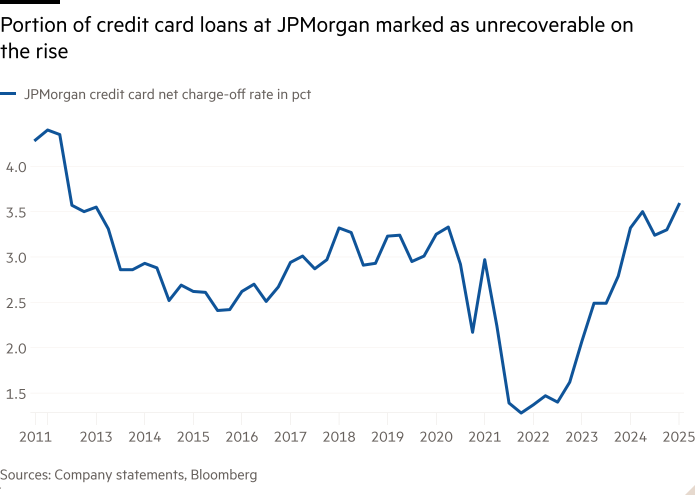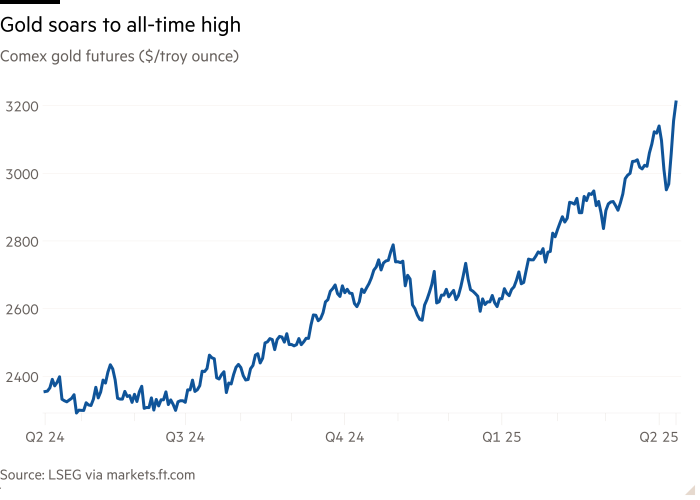Warning lights flash for US consumer strength as credit defaults rise

Unlock the White House Watch newsletter for free
Your guide to what the 2024 US election means for Washington and the world
US consumers are showing increasing signs of financial stress as they brace for higher prices from the Trump’s administration’s tariffs on imports, raising concerns about a crucial driver of the US economy.
In first-quarter earnings, JPMorgan said the portion of loans in its credit card business deemed unrecoverable rose to a 13-year high.
Industry-wide, the rate of charge-offs is now higher than the level before the Covid-19 outbreak, reversing a period of stellar credit card payments during the pandemic when consumers benefited from government stimulus programmes.
Consumer spending is the bedrock of the US economy, and after years of robust strength there are growing signs that Americans’ wellspring of financial firepower is fading. That poses a risk to economic growth at a time of rising prices and higher interest rates, amid greater concerns that the US economy may tip into a recession in the next 12 months.
JPMorgan chief executive Jamie Dimon said “there’s a wide range of potential outcomes” in a period of so much uncertainty, and sided with his bank’s economists that the odds of a recession were 50/50.
There are worries that consumers face added strain from higher prices linked to US President Donald Trump’s plans for a 10 per cent levy on imports as well as a tariff of 145 per cent on goods purchased from China.
“Looking at the April data is what would appear to be a little bit of front loading of spending, specifically in items that might have prices go up as a function of tariffs,” said JPMorgan chief financial officer Jeremy Barnum.
US consumer sentiment has been plunging since December amid “growing worries about trade war developments”, the University of Michigan said in a preliminary poll released on Friday. The share of survey respondents who expect greater unemployment in the year ahead was the highest since 2009.
Store foot traffic data from Placer.ai, which aggregates location signals from mobile phones, suggested US shoppers flocked to low-priced warehouse club stores in the last week of March, a sign they might be stocking up ahead of new tariffs.
At Walmart, the largest US retailer with both hypermarkets and a warehouse chain, chief financial officer John David Rainey this week pointed to “a little more sales volatility week-to-week and frankly, day-to-day” as consumer sentiment declines.
However, the company maintained its outlook for 3-4 per cent growth in US net sales for the quarter ending in April.

A report earlier in the week by the Philadelphia branch of the Federal Reserve showed the share of US credit card borrowers making only their minimum required payment hit a 12-year high at the end of 2024.
The Philadelphia Fed said the percentages of credit card accounts that were 30, 60 and 90 days past due had also increased in the fourth quarter.
“Collectively, these trends, along with a new series high for revolving card balances, indicate greater consumer stress,” the central bank’s Philadelphia branch wrote.
JPMorgan’s Barnum still struck an upbeat tone on consumer credit, saying that the bank’s “data is consistent with the narrative of the consumer being basically fine”.
He said cash buffers for lower income consumers were relatively weaker but that group was not showing signs of distress.
This view was backed up by Wells Fargo, the fourth-largest US bank by assets.
The bank’s net charge-off rate fell this quarter, though Wells has a far smaller credit card portfolio than JPMorgan.
“Customers continue to be resilient with stable customer activity in the quarter, including credit card and debit card spend,” said Wells chief financial officer Mike Santomassimo.
Dimon said that the crucial arbiter for loan losses would be the unemployment rate, currently at about 4.2 per cent.
“Credit almost always relates to employment,” Dimon said. “And so you guys can watch unemployment and [credit quality] will change when unemployment changes.”
Additional reporting by Akila Quinio





